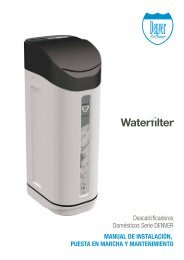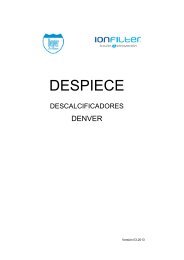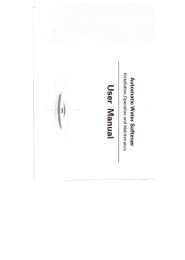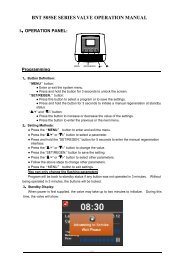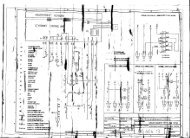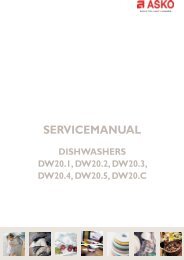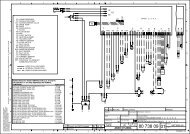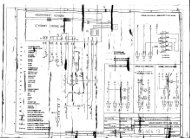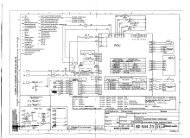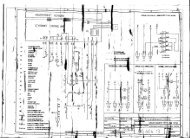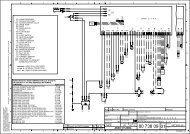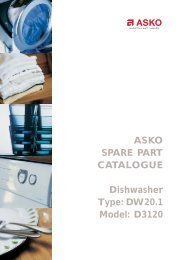MU_STRATOS_ENG_HI
You also want an ePaper? Increase the reach of your titles
YUMPU automatically turns print PDFs into web optimized ePapers that Google loves.
1. Presentation<br />
2. INTRODUCTION<br />
These systems come with a residual hardness regulator as<br />
standard, which allows selecting the appropriate hardness for<br />
your home.<br />
Its friendly-use electronic programmer will allow you to put the<br />
system into operation in an easy and fast manner.<br />
2.1 What Is Hardness?<br />
Hardness is the quantity of scaling salts present in water,<br />
which are mainly composed of low solubility salts of calcium<br />
and magnesium. The main salts causing hardness are listed<br />
below:<br />
Calcium bicarbonate:<br />
Calcium chloride:<br />
Calcium sulphate:<br />
Magnesium bicarbonate:<br />
Magnesium chloride:<br />
Magnesium sulphate:<br />
Ca(CO3H) 2<br />
CaCl2<br />
CaSO4<br />
Mg(CO3H) 2<br />
MgCl2<br />
MgSO4<br />
These salts, due to its chemical properties, have a tendency<br />
to precipitate, producing scale on pipes and obstructing<br />
them as they accumulate. In the same way, hardness has a<br />
high tendency to scale on electrical resistors from heaters<br />
and to precipitate into heaters when temperature increases.<br />
The combination of hard minerals and soap produces a soap<br />
curdling. This soap curdling reduces the cleansing properties<br />
of soap. Hard minerals precipitation builds a layer on cooking<br />
utensils, connections and plumbing fixtures. It may even alter<br />
the taste of food.<br />
MAIN PROBLEMS<br />
Precipitation on pipes, fixtures and appliances.<br />
Precipitation on electrical resistors, increase on energy<br />
consumption due to the generated isolation.<br />
Higher consumption of soap and chemical products.<br />
Reduction of the electrical appliances’ service life and<br />
greater maintenance.<br />
All these problems are solved when using a water softener,<br />
since water obtained after being treated by the system is<br />
completely free of scaling salts.<br />
For the most part of Europe, hardness is indicated in French<br />
hydrometric degrees, but there are also other measuring<br />
units, according to each region.<br />
Below are the most usual equivalences.<br />
UNITS<br />
1 ppm of Calcium<br />
1 ppm of Magnesium<br />
1 ppm of CaCO3<br />
1º French (ºHF)<br />
1º German (ºd)<br />
1º English (ºe)<br />
1 mmol/L<br />
1 mval/L=meq/L<br />
ppm of CaCO3<br />
2,5<br />
4,13<br />
1<br />
10<br />
17,8<br />
14,3<br />
100<br />
50<br />
2.2 How Does Your System Work?<br />
º French<br />
0.25<br />
0.413<br />
0.1<br />
1<br />
1.78<br />
1.43<br />
10<br />
5<br />
Water softening is carried out by means of an ion exchange<br />
process. On this purpose, the system uses resins with the<br />
chemical capacity of capturing Calcium (Ca) and Magnesium<br />
(Mg) ions and removing them from water.<br />
When Calcium and Magnesium ions are captured by the<br />
resin, two Sodium (Na) ions are released which, due to its<br />
chemical properties, produce salts with a higher solubility<br />
avoiding all hardness-related problems.<br />
Therefore, when water gets softened, its sodium level increases.<br />
Further information on this procedure can be found in ‘Section<br />
2.8’.<br />
ION EXCHANGE RESINS:<br />
They are synthetic compounds, usually with an spherical<br />
shape, able to capture certain chemical substances present<br />
in water, which then exchanges for other substances.<br />
Water softening uses strong cation resins, which are composed<br />
of styrene copolymers and divinylbenzene with a<br />
sulphur base.<br />
7




